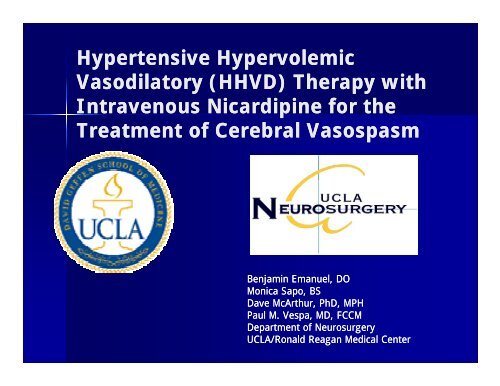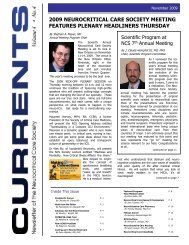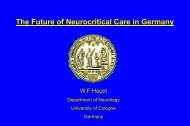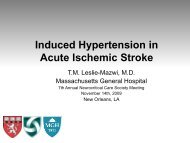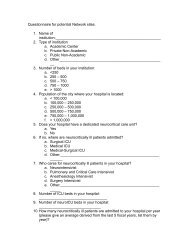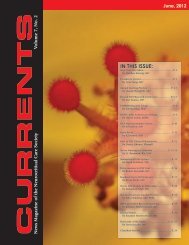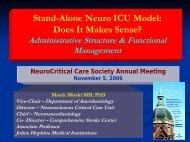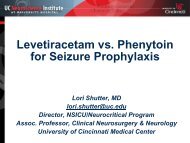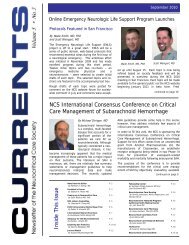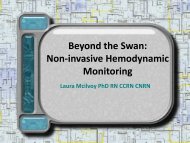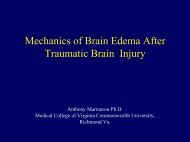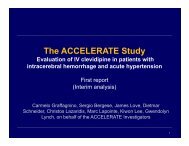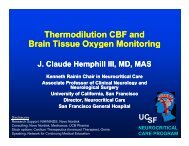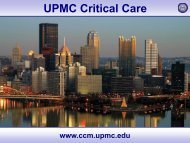Hypertensive Hypervolemic Vasodilatory (HHVD) Therapy with ...
Hypertensive Hypervolemic Vasodilatory (HHVD) Therapy with ...
Hypertensive Hypervolemic Vasodilatory (HHVD) Therapy with ...
Create successful ePaper yourself
Turn your PDF publications into a flip-book with our unique Google optimized e-Paper software.
<strong>Hypertensive</strong> <strong>Hypervolemic</strong><br />
<strong>Vasodilatory</strong> (<strong>HHVD</strong>) <strong>Therapy</strong> <strong>with</strong><br />
Intravenous Nicardipine for the<br />
Treatment of Cerebral Vasospasm<br />
Benjamin Emanuel, DO<br />
Monica Sapo, BS<br />
Dave McArthur, PhD, MPH<br />
Paul M. M Vespa, Vespa MD MD, FCCM<br />
Department of Neurosurgery<br />
UCLA/Ronald Reagan Medical Center
No Disclosures
Background<br />
�The standard of care for cerebral vasospasm has been hypertensive<br />
hypervolemic hemodilution (HHH) therapy in an attempt to increase<br />
cerebral b l blood bl d flow, fl and d calcium l i channel h l antagonists i (CCA) as<br />
preventive or rescue therapy.<br />
-Nimodipine p – intravenous, , intra-arterial, , oral<br />
-Verapamil – intra-arterial<br />
-Nicardipine – intravenous, intra-arterial, intracranial<br />
biocompatible controlled release systems<br />
�However, continuous intravenous CCA have not been used as a<br />
therapeutic p option p<br />
at the onset of CV.
The Big Idea<br />
Would hypertensive hypervolemic therapy <strong>with</strong> a continuous<br />
intravenous infusion of nicardipine at the onset of cerebral<br />
vasospasm induce a progressive arterial vasodilatation resulting in a<br />
decrease in TCD TCD velocities?<br />
velocities?
Methods<br />
�� Retrospective study of a prospective, nonrandomized crossover feasibility<br />
protocol of <strong>HHVD</strong> vs hypertensive hypervolemia (HH) alone over 4 years<br />
(2005 – 2009)<br />
�� Daily Transcranial Doppler (TCD) mean velocities (MV) of the anterior and<br />
middle cerebral cerebral arteries were were completed<br />
�� HH therapy began when TCD >120cm/sec, LR>3<br />
�� HH therapy was done for 48 hours<br />
�� Patients were crossed over from HH to <strong>HHVD</strong> if TCD velocities worsened<br />
despite despite HH HH therapy<br />
�� For <strong>HHVD</strong>, nicardipine was infused at 2mg/hr while SBP goals kept<br />
unchanged using norepinephrine<br />
�� The primary outome was the rate in decline of TCD velocity<br />
�� Data was analyzed y for p progressive g arterial dilation between the two therapies, p ,<br />
incidence of rescue therapy, symptomatic versus asymptomatic vasospasm,<br />
DINDS, difference in rate of norepinephrine infusion, hypotension, and<br />
myocardial infarction (MI) defined as Troponin >5.0 ng/mL
Demographics<br />
� <strong>HHVD</strong> group*<br />
– 16 patients<br />
–Fisher grade<br />
� Grade 3+4: 10<br />
�� Grade 3: 5<br />
� Grade unknown: 1<br />
– M:F 3:13<br />
� HH group*<br />
– 20 patients<br />
–Fisher grade<br />
� Grade 3+4: 14<br />
�� Grade 3: 5<br />
� Grade 2: 1<br />
– M:F 9:11<br />
–Average age 47 –Average age 51<br />
*The *There e was as no statistical diffe difference ence bet between een the ttwo o ggroups. o ps
Transcranial Doppler<br />
Doppler<br />
Velocities for the first 5 days<br />
Figure 1: The first 5 days after the start of <strong>HHVD</strong><br />
therapy<br />
Figure 2: The first 5 days after the start of HH<br />
therapy alone.<br />
On average, the start of <strong>HHVD</strong> therapy showed a progressive decline in<br />
mean velocity of 4.1 days sooner then HH therapy alone (p=0.012). The<br />
rate of decline for <strong>HHVD</strong> was 6 cm/sec/day compared to 0 cm/sec/day in<br />
the HH group.
Velocities >180 and<br />
200cm/sec<br />
Figure 3: Showing the<br />
percentage of time mean<br />
velocities spent >180cm/sec 180cm/sec<br />
and 200cm/sec for <strong>HHVD</strong><br />
and HH groups. Velocities<br />
>180cm/sec for <strong>HHVD</strong><br />
18.92%, HH 24.36%, pp=n.s. n.s.<br />
Velocities >200 for <strong>HHVD</strong><br />
11.85%, for HH 13.13%,<br />
p=n.s.
Rescue <strong>Therapy</strong> py Between<br />
Groups<br />
35<br />
30<br />
25<br />
20<br />
15<br />
10<br />
5<br />
0<br />
# IA rescue events during<br />
therapy<br />
<strong>HHVD</strong> HH<br />
# IA rescue events<br />
during therapy<br />
Figure 4: Frequency of rescue<br />
therapy between <strong>HHVD</strong> and HH<br />
groups. HH group required rescue<br />
th therapy 35 ti times, while hil the th<br />
<strong>HHVD</strong> group required treatment on<br />
19 occasions.
Systolic y Blood Pressure<br />
Between the Two Groups<br />
Figure 6: Systolic blood pressure<br />
(SBP) between the <strong>HHVD</strong> and HH<br />
groups. (<strong>HHVD</strong> vs HH: mean 161<br />
vs 173 mmHg, p=0.024).
Incidence of inadvertent<br />
18000<br />
hhypotension i<br />
Events of SBP
Norepinephrine infusion<br />
ug/k/m inn<br />
0.6<br />
0.5<br />
0.4<br />
0.3<br />
0.2<br />
0.1<br />
0<br />
Mean Dose of Norepi<br />
HH <strong>HHVD</strong><br />
� On average, the HH group<br />
had a higher rate of<br />
norepinephrine p p infusion<br />
(0.300 vs 0.268<br />
mcg/kg/min; SD=0.194 vs<br />
0.230, ,p p
�There was no difference between the two groups<br />
<strong>with</strong> regard to symptomatic or asymptomatic<br />
vasospasm, DINDS, or MI.
Conclusion<br />
�� <strong>HHVD</strong> therapy showed a progressive decline<br />
in mean cerebral velocities of 6 cm/sec/day,<br />
<strong>with</strong> vasospasm ending ending 4.1 4 1 days days sooner sooner as<br />
as<br />
compared to HH therapy alone.<br />
�� �� Furthermore, <strong>HHVD</strong> may reduce the need<br />
for rescue intra intra-arterial arterial therapy. However,<br />
<strong>HHVD</strong> therapy was complicated by more<br />
h hypotensive t i events t and d lower l mean SBP. SBP<br />
Larger studies are needed to confirm these<br />
results.
References<br />
1.Reddy P, Yeh YC. Use of injectable nicardipine for neurovascular indications. Pharmacotherapy. 2009 Apr;29(4):398-409.<br />
2.Barth M, Thomé C, Schmiedek P, Weiss C, Kasuya H, Vajkoczy P. Characterization of functional outcome and quality of life<br />
following subarachnoid hemorrhage in patients treated <strong>with</strong> and <strong>with</strong>out nicardipine prolonged-release implants. J Neurosurg.<br />
2009 May;110(5):955-60.<br />
3.Omeis I, Neil JA, Murali R, Abrahams JM. Treatment of cerebral vasospasm <strong>with</strong> biocompatible controlled-release systems for<br />
intracranial drug delivery. Neurosurgery. 2008 Dec;63(6):1011-9; discussion 1019-21.<br />
4.Nogueira RG, Lev MH, Roccatagliata L, Hirsch JA, Gonzalez RG, Ogilvy CS, Halpern EF, Rordorf GA, Rabinov JD, Pryor JC.<br />
Intra-arterial nicardipine infusion improves CT perfusion-measured cerebral blood flow in patients <strong>with</strong> subarachnoid<br />
hemorrhage-induced vasospasm. AJNR Am J Neuroradiol. 2009 Jan;30(1):160-4. Epub 2008 Oct 22.<br />
5.Kronvall E, Undrén P, Romner B, Säveland H, Cronqvist M, Nilsson OG. Nimodipine in aneurysmal subarachnoid hemorrhage: a<br />
randomized study of intravenous or peroral administration. J Neurosurg. 2009 Jan;110(1):58-63.<br />
6.Hänggi D, Turowski B, Beseoglu K, Yong M, Steiger HJ.Intra-arterial nimodipine for severe cerebral vasospasm after aneurysmal<br />
subarachnoid hemorrhage: influence on clinical course and cerebral perfusion. AJNR Am J Neuroradiol. 2008<br />
Jun;29(6):1053-60.<br />
7.Mazumdar A, Rivet DJ, Derdeyn CP, Cross DT 3rd, Moran CJ. Effect of intraarterial verapamil on the diameter of vasospastic<br />
intracranial arteries in patients <strong>with</strong> cerebral vasospasm. Neurosurg Focus. 2006 Sep 15;21(3):E15.<br />
8.Kasuya H, Onda H, Sasahara A, Takeshita M, Hori T. Application of nicardipine prolonged-release implants: analysis of 97<br />
consecutive patients <strong>with</strong> acute subarachnoid hemorrhage. Neurosurgery. 2005 May;56(5):895-902.<br />
9.Shibuya M, Suzuki Y, Enomoto H, Okada T, Ogura K, Sugita K.Effects of prophylactic intrathecal administrations of nicardipine on<br />
vasospasm in patients <strong>with</strong> severe aneurysmal subarachnoid haemorrhage. Acta Neurochir (Wien). 1994;131(1-2):19-25.<br />
10.Gilsbach JM, Reulen HJ, Ljunggren B, Brandt L, von Holst H, Mokry M, von Essen C, Conzen MA. Early aneurysm surgery and<br />
preventive therapy <strong>with</strong> intravenously administered nimodipine: a multicenter multicenter, double double-blind, blind dose-comparison dose comparison study study.<br />
Neurosurgery. 1990 Mar;26(3):458-64.<br />
11.Grotenhuis JA, Bettag W.Prevention of symptomatic vasospasm after SAH by constant venous infusion of nimodipine. Neurol<br />
Res. 1986 Dec;8(4):243-9.<br />
12.Philippon J, Grob R, Dagreou F, Guggiari M, Rivierez M, Viars P.Prevention of vasospasm in subarachnoid haemorrhage. A<br />
controlled study <strong>with</strong> nimodipine. Acta Neurochir (Wien). 1986;82(3-4):110-4.<br />
13.Haley EC Jr, Kassell NF, Torner JC, Truskowski LL, Germanson TP. A randomized trial of two doses of nicardipine in<br />
aneurysmal subarachnoid hemorrhage. hemorrhage A report of the Cooperative Aneurysm Study Study.J J Neurosurg Neurosurg. 1994 May;80(5):788-96<br />
May;80(5):788 96.<br />
14.Haley EC Jr, Kassell NF, Torner JC. A randomized trial of nicardipine in subarachnoid hemorrhage: angiographic and<br />
transcranial Doppler ultrasound results. A report of the Cooperative Aneurysm Study,1993 Apr;78(4):548-53.<br />
15.Haley EC Jr, Kassell NF, Torner JC. A randomized controlled trial of high-dose intravenous nicardipine in aneurysmal<br />
subarachnoid hemorrhage. A report of the Cooperative Aneurysm Study, J Neurosurg. 1993 Apr;78(4):537-47.


